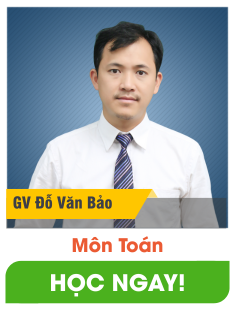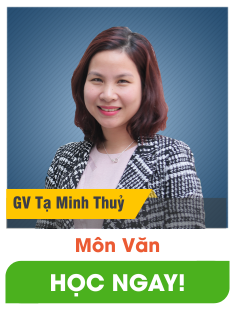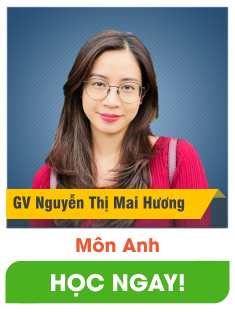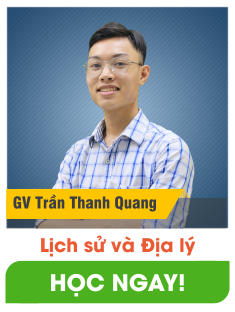Đề thi học kì 2 Tiếng Anh 6 Right on! - Đề số 3Tải về I. Find the word whose underlined part differs from the other three in pronunciation. II. Choose the correct answers. III. Listen to an advert about the Charles Dickens Museum and decide whether the following statements are True or False. IV. Read the text and decide if the statements are True or False. V. Read the text and choose the correct answers. GÓP Ý HAY - NHẬN NGAY QUÀ CHẤT Gửi góp ý cho HocTot.Nam.Name.Vn và nhận về những phần quà hấp dẫn
Lựa chọn câu để xem lời giải nhanh hơn
Đề bài I. Find the word whose underlined part differs from the other three in pronunciation. 1. A. study B. sleep C. school D. island 2. A. improved B. waited C. collected D. attended 3. A. plane B. camping C. kayaking D. rafting 4. A. best B. tent C. jacket D. get 5. A. checked B. watched C. needed D. wished II. Choose the correct answers. 6. Last summer we went to Nha Trang beach. It was _____ and _____ so we went swimming every day. A. rainy - cloudy B. sunny - cold C. sunny - hot D. stormy - windy 7. My sister enjoys watching ______. She learns a lot of delicious recipes. A. action movies B. documentaries C. cookery shows D. cartoons 8. Let’s go to the ______ with us this weekend. I know you love riding roller coasters there. A. amusement park B. market C. theatre D. stadium 9. In Hanoi, I usually go by ______. It’s cheap and quite convenient to use the public transport. A. car B. plane C. bus D. motorcycle 10. Linh likes listening to classical music so she usually visits the _____. A. circus B. stadium C. concert hall D. exhibition centre 11. Are you going to the supermarket? Can you buy me a ______ of bread and 300 _____ of beef? A. slice - kilo B. bar - packet C. loaf - grams D. can - packet 12. Look! John is walking _______ the road. A. across B. to C. on D. above 13. When you go camping, you _____ clean the place before coming home. A. will B. shouldn’t C. have to D. don’t have to 14. The sky is blue and clear today. It ______ a beautiful day! A. was B. will be C. be D. is going to be 15. If Peter ____ Paris, he ______ us some souvenirs. A. visited – will buy B. visits – will buy C. will visit – buy D. visit – buy 16. My grandfather ______ that shelf for us to store our books 5 years ago. A. is make B. made C. is making D. didn’t make 17. Would you like to join our party this Friday night? – I’m sorry I can’t. We ______ visiting our grandparents this weekend. A. go B. are C. is D. be 18. I was _____ to see the latest movie but it was ______. A. excited - boring B. exciting - bored C. exciting - boring D. bored - excited 19. We ______ less if we _____ our tickets now. A. pay – not book B. will pay – will book C. will pay - book D. pay – are booking 20. Are these _____ notebooks? Anna and Steve said that they aren’t ________. A. your - them B. you - their C. your - theirs D. you - them III. Listen to an advert about the Charles Dickens Museum and decide whether the following statements are True or False. 21. The Charles Dickens Museum is located in London. 22. The author wrote Oliver Twist in a different house. 23. Visitors can visit the Museum from 8:00 A.M. 24. The museum isn’t open on Mondays. 25. Children under the age of 6 don’t need to pay for their tickets. IV. Read the text and decide if the statements are True or False. MARIE CURIE Marie Curie was a Polish-French scientist who won two Nobel prizes. Her work focused on radioactivity. Marie Curie was born in Warsaw, Poland on November 7, 1867. Her parents were teachers who valued education. Girls did not go to school in those days, so Marie and her sister, Bronislawa, saved enough money to study in France. In 1891 Maria entered the Sorbonne, a university in Paris. Within three years, Marie completed degrees in physics and math. She began working with a French scientist, Pierre Curie. They got married in 1895. In 1896 a French scientist named Henri Becquerel discovered the unusual rays of energy from uranium. Marie began studying it, and she named radioactivity. In 1898 the Curies announced their discovery of radium and polonium. In 1903 the Curies shared the Nobel Prize for Physics with Becquerel. After Pierre died in 1906, Marie carried on their research. She also became the first woman professor at the Sorbonne. In 1911 she won the Nobel Prize for Chemistry. Marie did not realize that working with radioactive material could make her ill. She died on July 4, 1934. 26. Marie Curie was born in France on November 7, 1867. 27. She moved to France to continue her study because girls did not go to school those days. 28. It took Marie four years to finish her university degrees. 29. Marie married a French scientist named Pierre Curie in 1895. 30. Marie won two Nobel Prizes. V. Read the text and choose the correct answers. Dear Julie, I’m so glad that you are coming to Vietnam for your vacation. It’s beautiful! When you’re here, you (31) _____ to see some of Vietnam’s natural wonders. Moc Chau Highland and Cuc Phuong National (32) _____ are two beautiful places in the (33) _______ of Vietnam. There are some really pretty villages, huge forests and amazing waterfalls. We can go to both places by (34) _____ or bus. You should also go to Phu Quoc (35) ______ and Lang Co Bay. They have white sand beaches. You should go scuba diving and snorkeling there. Those places are famous for their delicious seafood, too. We can visit Phu Quoc by plane or boat. See you soon, Minh. 31. A. will B. should C. should travel D. won’t travel 32. A. waterfall B. mountain C. park D. river 33. A. west B. north C. south D. east 34. A. train B. bike C. boat D. taxis 35. A. highland B. island C. waterfall D. mountain VI. Make a suitable question for the underlined part in each sentence. 36. Vincent van Gogh was born in the Netherlands. ___________________________________________. 37. My mom is cooking dinner in the kitchen. ___________________________________________. 38. Our family went to Lang Co Bay last summer holiday. ___________________________________________. VII. Rewrite the following sentences without changing the meaning. 39. It isn’t a good idea to speak loudly in a museum. (should) ___________________________________________. 40. It’s a possibility that our class will visit the amusement park this weekend. (might) ___________________________________________. ----------------------THE END---------------------- Đáp án HƯỚNG DẪN GIẢI Thực hiện: Ban chuyên môn HocTot.Nam.Name.Vn
36. Where was Vincent van Gogh born? 37. Who is cooking dinner in the kitchen? 38. When did your family go to Lang Co Bay? 39. You shouldn’t speak loudly in a museum. 40. Our class might visit the amusement park this weekend. HƯỚNG DẪN GIẢI CHI TIẾT 1. D Kiến thức: Cách phát âm “s” Giải thích: A. study /ˈstʌdi/ B. sleep /sliːp/ C. school /skuːl/ D. island /ˈaɪlənd/ Phần gạch chân phương án D không được phát âm, còn lại phát âm là /s/. Đáp án D 2. A Kiến thức: Cách phát âm “ed” Giải thích: A. improved /ɪmˈpruːvd/ B. waited /ˈweɪtɪd/ C. collected /kəˈlektɪd/ D. attended /əˈtendɪd/ Cách phát âm đuôi “ed”: + Đuôi “ed” được phát âm là /t/ khi động từ có phát âm kết thúc là /tʃ/, /θ/, /ʃ/, /s/, /k/, /p/, /f/ + Đuôi “ed” được phát âm là /ɪd/ khi động từ có phát âm kết thúc là /t/, /d/ + Đuôi “ed” được phát âm là /d/ với các trường hợp còn lại Phần gạch chân phương án A phát âm là /d/, còn lại phát âm là /ɪd/. Đáp án A 3. A Kiến thức: Cách phát âm “a” Giải thích: A. plane /pleɪn/ B. camping /ˈkæmpɪŋ/ C. kayaking /ˈkaɪækɪŋ/ D. rafting /ˈræftɪŋ/ Phần gạch chân phương án A phát âm là /eɪ/, còn lại phát âm là /æ/. Đáp án A 4. C Kiến thức: Cách phát âm “e” Giải thích: A. best /best/ B. tent /tent/ C. jacket /ˈdʒækɪt/ D. get /ɡet/ Phần gạch chân phương án C phát âm là /æ/, còn lại phát âm là /e/. Đáp án C 5. C Kiến thức: Cách phát âm “ed” Giải thích: A. checked /tʃekt/ B. watched /wɒtʃt/ C. needed /ˈniːdɪd/ D. wished /wɪʃt/ Cách phát âm đuôi “ed”: + Đuôi “ed” được phát âm là /t/ khi động từ có phát âm kết thúc là /tʃ/, /θ/, /ʃ/, /s/, /k/, /p/, /f/ + Đuôi “ed” được phát âm là /ɪd/ khi động từ có phát âm kết thúc là /t/, /d/ + Đuôi “ed” được phát âm là /d/ với các trường hợp còn lại Phần gạch chân phương án C phát âm là /ɪd/, còn lại phát âm là /t/. Đáp án C 6. C Kiến thức: Từ vựng Giải thích: A. rainy – cloudy: mưa – nhiều mây B. sunny – cold: nắng – lạnh C. sunny – hot: nắng – nóng D. stormy – windy: có bão – có gió Last summer we went to Nha Trang beach. It was sunny and hot so we went swimming every day. (Mùa hè năm ngoái chúng tôi đi biển Nha Trang. Trời nắng và nóng nên ngày nào chúng tôi cũng đi bơi.) Đáp án C 7. C Kiến thức: Từ vựng Giải thích: A. action movies (n): phim hành động B. documentaries (n): phim tài liệu C. cookery shows (n): chương trình nấu ăn D. cartoons (n): phim hoạt hình My sister enjoys watching cookery shows. She learns a lot of delicious recipes. (Em gái tôi thích xem các chương trình nấu ăn. Em ấy học rất nhiều công thức nấu ăn ngon.) Đáp án C 8. A Kiến thức: Từ vựng Giải thích: A. amusement park (n): công viên giải trí B. market (n): chợ C. theatre (n): rạp hát D. stadium (n): sân vận động Let’s go to the amusement park with us this weekend. I know you love riding roller coasters there. (Cuối tuần này hãy đến công viên giải trí với chúng tôi. Tôi biết bạn thích đi tàu lượn siêu tốc ở đó.) Đáp án A 9. C Kiến thức: Từ vựng Giải thích: A. car (n): ô tô B. plane (n): máy bay C. bus (n): xe buýt D. motorcycle (n): xe máy In Hanoi, I usually go by bus. It’s cheap and quite convenient to use the public transport. (Ở Hà Nội, tôi thường đi bằng xe buýt. Giá rẻ và khá thuận tiện khi sử dụng phương tiện giao thông công cộng.) Đáp án C 10. C Kiến thức: Từ vựng Giải thích: A. circus (n): rạp xiếc B. stadium (n): sân vận động C. concert hall (n): phòng hoà nhạc D. exhibition centre (n): trung tâm triển lãm Linh likes listening to classical music, so she usually visits the concert hall. (Linh thích nghe nhạc cổ điển nên thường đến phòng hòa nhạc.) Đáp án C 11. C Kiến thức: Từ vựng Giải thích: A. slice – kilo: miếng – kilo B. bar – packet: thanh – gói C. loaf – grams: ổ – gram D. can – packet: lon – gói Are you going to the supermarket? Can you buy me a loaf of bread and 300 grams of beef? (Bạn đang đi đến siêu thị phải không? Bạn có thể mua cho tôi một ổ bánh mì và 300 gram thịt bò được không?) Đáp án C 12. A Kiến thức: Giới từ Giải thích: A. across (prep): băng qua B. to (prep): tới C. on (prep): trên D. above (prep): bên trên Look! John is walking across the road. (Nhìn kìa! John đang đi băng qua đường.) Đáp án A 13. C Kiến thức: Động từ khuyết thiếu Giải thích: A. will: sẽ B. shouldn’t: không nên C. have to: phải D. don’t have to: không phải When you go camping, you have to clean the place before coming home. (Khi bạn đi cắm trại, bạn phải dọn dẹp nơi đó trước khi về đến nhà.) Đáp án C 14. D Kiến thức: Thì Tương lai gần Giải thích: Cách dùng: Đưa ra một giả thuyết ở tương lai, có dấu hiệu. Cấu trúc: S + am/ is/ are + going to + V_infinitive The sky is blue and clear today. It is going to be a beautiful day! (Bầu trời hôm nay trong xanh. Đây sẽ là một ngày đẹp trời!) Đáp án D 15. B Kiến thức: Câu điều kiện loại 1 Giải thích: Cấu trúc: If + S + V_(s/es), S + will/ can/ may + V_infinitive Cách dùng: Diễn tả 1 điều kiện có thể xảy ra ở hiện tại hoặc tương lai If Peter visits Paris, he will buy us some souvenirs. (Nếu Peter đến thăm Paris, anh ấy sẽ mua quà lưu niệm cho chúng tôi.) Đáp án B 16. B Kiến thức: Thì quá khứ đơn Giải thích: Dấu hiệu nhận biết: “5 years ago” – 5 năm trước => chia thì quá khứ đơn Thì quá khứ đơn: S + V_ed/ cột 2 Diễn tả 1 hành động đã xảy ra trong quá khứ My grandfather made that shelf for us to store our books 5 years ago. (Ông tôi đã làm chiếc kệ đó để chúng tôi cất sách cách đây 5 năm.) Đáp án B 17. B Kiến thức: Thì hiện tại tiếp diễn Giải thích: Cấu trúc: S + am/ is/ are + V_ing Cách dùng: Diễn tả 1 hành động sẽ xảy ra trong tương lai, có sắp xếp dự định từ trước. Would you like to join our party this Friday night? – I’m sorry I can’t. We are visiting our grandparents this weekend. (Bạn có muốn tham gia bữa tiệc của chúng tôi vào tối thứ Sáu này không? - Tôi xin lỗi, tôi không thể. Chúng tôi sẽ đến thăm ông bà vào cuối tuần này.) Đáp án B 18. A Kiến thức: Từ vựng Giải thích: excited (adj): cảm thấy hào hứng exciting (adj): thú vị bored (adj): cảm thấy chán, buồn chán boring (adj): nhàm chán Tính từ đuôi “ed” thể hiện cảm xúc, tính từ đuôi “ing” thể hiện bản chất I was excited to see the latest movie, but it was boring. (Tôi đã rất hào hứng để xem bộ phim mới nhất nhưng nó thật nhàm chán.) Đáp án A 19. C Kiến thức: Câu điều kiện loại 1 Giải thích: Cấu trúc: S + will/ can/ may + V_infinitive if + S + V_(s/es). Cách dùng: Diễn tả 1 điều kiện có thể xảy ra ở hiện tại hoặc tương lai We will pay less if we book our tickets now. (Chúng ta sẽ trả ít hơn nếu chúng ta đặt vé ngay bây giờ.) Đáp án C 20. C Kiến thức: Từ vựng Giải thích: Tính từ sở hữu luôn đứng trước danh từ Đại từ sở hữu đóng vai trò làm chủ ngữ/ tân ngữ, không đi kèm danh từ Are these your notebooks? Anna and Steve said that they aren’t theirs. (Đây là vở của bạn phải không? Anna và Steve nói rằng chúng không phải vở của họ.) Đáp án C 21. T Kiến thức: Nghe hiểu Giải thích: The Charles Dickens Museum is located in London. (Bảo tàng Charles Dickens nằm ở London.) Thông tin: Then why not pay a visit to the home of their famous author Charles Dickens at 48 Doughty St in London. (Vậy thì tại sao bạn không đến thăm nhà của tác giả nổi tiếng Charles Dickens tại 48 Doughty St ở London.) Đáp án T 22. F Kiến thức: Nghe hiểu Giải thích: The author wrote Oliver Twist in a different house. (Tác giả đã viết Oliver Twist trong một ngôi nhà khác.) Thông tin: Dickens lived in this lovely old Georgian house from 1837 to 1839 and wrote several of his novels here including Oliver Twist. (Dickens đã sống trong ngôi nhà Georgia cổ kính xinh xắn này từ năm 1837 đến năm 1839 và đã viết một số tiểu thuyết của mình ở đây bao gồm cả Oliver Twist.) Đáp án F 23. F Kiến thức: Nghe hiểu Giải thích: Visitors can visit the Museum from 8:00 A.M. (Du khách có thể đến thăm Bảo tàng từ 8:00 A.M.) Thông tin: We are open from 10:00 o'clock in the morning until 5:00 o'clock in the evening, everyday except Mondays. (Chúng tôi mở cửa từ 10 giờ sáng đến 5 giờ tối, hàng ngày trừ Thứ Hai.) Đáp án F 24. T Kiến thức: Nghe hiểu Giải thích: The museum isn’t open on Mondays. (Bảo tàng không mở cửa vào các ngày Thứ Hai.) Thông tin: We are open from 10:00 o'clock in the morning until 5:00 o'clock in the evening, everyday except Mondays. (Chúng tôi mở cửa từ 10 giờ sáng đến 5 giờ tối, hàng ngày trừ Thứ Hai.) Đáp án T 25. T Kiến thức: Nghe hiểu Giải thích: Children under the age of 6 don’t need to pay for their tickets. (Trẻ em dưới 6 tuổi không cần trả tiền vé.) Thông tin: Admission for children under the age of 6 is free. (Trẻ em dưới 6 tuổi được vào miễn phí.) Đáp án T Bài nghe: Are you planning a visit to England? Do you enjoy books and reading? Then why not pay a visit to the home of their famous author Charles Dickens at 48 Doughty St in London. Dickens lived in this lovely old Georgian house from 1837 to 1839 and wrote several of his novels here including Oliver Twist. Now the House is a museum and visitors can walk around and see where Dickens lived and worked. We are open from 10:00 o'clock in the morning until 5:00 o'clock in the evening, everyday except Mondays. Tickets are £9 for adults and four pounds for children between the ages of 6 and 16. Admission for children under the age of 6 is free. You can book tickets online or on the telephone number is 020 7405 2127. Tạm dịch: Bạn đang lên kế hoạch cho một chuyến thăm đến Anh? Bạn có thích sách và đọc không? Vậy thì tại sao bạn không đến thăm nhà của tác giả nổi tiếng Charles Dickens tại 48 Doughty St ở London. Dickens đã sống trong ngôi nhà Georgia cổ kính xinh xắn này từ năm 1837 đến năm 1839 và đã viết một số tiểu thuyết của mình ở đây bao gồm cả Oliver Twist. Bây giờ Ngôi nhà là một bảo tàng và du khách có thể đi bộ xung quanh và xem nơi Dickens đã sống và đã làm việc. Chúng tôi mở cửa từ 10 giờ sáng đến 5 giờ tối, hàng ngày trừ Thứ Hai. Vé là £9 cho người lớn và £4 cho trẻ em từ 6 đến 16 tuổi. Trẻ em dưới 6 tuổi được vào miễn phí. Bạn có thể đặt vé trực tuyến hoặc qua số điện thoại là 020 7405 2127. 26. F Kiến thức: Đọc hiểu Giải thích: Marie Curie was born in France on November 7, 1867. (Marie Curie sinh ra tại Pháp vào ngày 7 tháng 11 năm 1867.) Thông tin: Marie Curie was born in Warsaw, Poland on November 7, 1867. (Marie Curie sinh ra ở Warsaw, Ba Lan vào ngày 7 tháng 11 năm 1867.) Đáp án F 27. T Kiến thức: Đọc hiểu Giải thích: She moved to France to continue her study because girls did not go to school those days. (Bà ấy chuyển đến Pháp để tiếp tục việc học của mình vì những ngày đó con gái không đến trường.) Thông tin: Girls did not go to school in those days, so Marie and her sister, Bronislawa, saved enough money to study in France. (Những ngày đó, con gái không được đến trường nên Marie và em gái, Bronislawa, đã tiết kiệm đủ tiền để sang Pháp du học.) Đáp án T 28. F Kiến thức: Đọc hiểu Giải thích: It took Marie four years to finish her university degrees. (Marie mất bốn năm để hoàn thành bằng đại học của mình.) Thông tin: Within three years, Marie completed degrees in physics and maths. (Trong vòng ba năm, Marie đã hoàn thành các bằng cấp về vật lý và toán học.) Đáp án F 29. T Kiến thức: Đọc hiểu Giải thích: Marie married a French scientist named Pierre Curie in 1895. (Marie kết hôn với một nhà khoa học người Pháp tên là Pierre Curie vào năm 1895.) Thông tin: She began working with a French scientist, Pierre Curie. They got married in 1895. (Bà bắt đầu làm việc với một nhà khoa học người Pháp là Pierre Curie. Họ kết hôn vào năm 1895.) Đáp án T 30. T Kiến thức: Đọc hiểu Giải thích: Marie won two Nobel Prizes. (Marie đã giành được hai giải Nobel.) Thông tin: Marie Curie was a Polish-French scientist who won two Nobel prizes. (Marie Curie là một nhà khoa học người Pháp gốc Ba Lan đã giành được hai giải Nobel.) Đáp án T Dịch bài đọc: MARIE CURIE Marie Curie là một nhà khoa học người Pháp gốc Ba Lan đã giành được hai giải Nobel. Công việc của bà tập trung vào phóng xạ. Marie Curie sinh ra ở Warsaw, Ba Lan vào ngày 7 tháng 11 năm 1867. Cha mẹ của bà là những giáo viên coi trọng giáo dục. Những ngày đó, con gái không được đến trường nên Marie và em gái, Bronislawa, đã tiết kiệm đủ tiền để sang Pháp du học. Năm 1891, Maria vào Sorbonne, một trường đại học ở Paris. Trong vòng ba năm, Marie đã hoàn thành các bằng cấp về vật lý và toán học. Bà bắt đầu làm việc với một nhà khoa học người Pháp là Pierre Curie. Họ kết hôn vào năm 1895. Năm 1896, một nhà khoa học người Pháp tên là Henri Becquerel đã phát hiện ra những tia năng lượng bất thường từ uranium. Marie bắt đầu nghiên cứu nó, và bà ấy đặt tên là phóng xạ. Năm 1898, nhà Curie công bố khám phá ra radium và polonium. Năm 1903, gia đình Curies chia sẻ giải Nobel Vật lý với Becquerel. Sau khi Pierre qua đời vào năm 1906, Marie tiếp tục nghiên cứu của họ. Bà cũng trở thành nữ giáo sư đầu tiên tại Sorbonne. Năm 1911, bà đoạt giải Nobel Hóa học. Marie không nhận ra rằng làm việc với chất phóng xạ có thể khiến bà bị bệnh. Bà mất ngày 4 tháng 7 năm 1934. 31. C Kiến thức: Thì hiện tại tiếp diễn Giải thích: A. will + V_infinitive: sẽ làm gì B. should + V_infinitive: nên làm gì C. should travel: nên đi D. won’t travel: sẽ không đi When you’re here, you (31) should travel to see some of Vietnam’s natural wonders. (Khi ở đây, bạn nên đi du lịch để ngắm một số kỳ quan thiên nhiên của Việt Nam.) Đáp án C 32. C Kiến thức: Từ vựng Giải thích: A. waterfall (n): thác nước B. mountain (n): núi C. park (n): công viên D. river (n): sông Moc Chau Highland and Cuc Phuong National (32) park are two beautiful places … (Cao nguyên Mộc Châu và vườn quốc gia Cúc Phương là hai địa điểm đẹp …) Đáp án C 33. B Kiến thức: Từ vựng Giải thích: A. west (n): phía tây B. north (n): phía bắc C. south (n): phía nam D. east (n): phía đông … in the (33) north of Vietnam. (… ở miền Bắc Việt Nam.) Đáp án B 34. A Kiến thức: Từ vựng Giải thích: A. train (n): tàu hoả B. bike (n): xe đạp C. boat (n): thuyền D. taxis (n): taxi We can go to both places by (34) train or bus. (Chúng ta có thể đến cả hai nơi bằng tàu hỏa hoặc xe buýt.) Đáp án A 35. B Kiến thức: Từ vựng Giải thích: A. highland (n): cao nguyên B. island (n): đảo C. waterfall (n): thác nước D. mountain (n): núi You should also go to Phu Quoc (35) island and Lang Co Bay. (Bạn cũng nên đến đảo Phú Quốc và Vịnh Lăng Cô.) Đáp án B Bài đọc hoàn chỉnh: Dear Julie, I’m so glad that you are coming to Vietnam for your vacation. It’s beautiful! When you’re here, you (31) should travel to see some of Vietnam’s natural wonders. Moc Chau Highland and Cuc Phuong National (32) park are two beautiful places in the (33) north of Vietnam. There are some really pretty villages, huge forests and amazing waterfalls. We can go to both places by (34) train or bus. You should also go to Phu Quoc (35) island and Lang Co Bay. They have white sand beaches. You should go scuba diving and snorkeling there. Those places are famous for their delicious seafood, too. We can visit Phu Quoc by plane or boat. See you soon, Minh. Dịch bài đọc: Julie thân mến, Tôi rất vui vì bạn sẽ đến Việt Nam trong kỳ nghỉ của mình. Việt Nam rất đẹp! Khi ở đây, bạn nên đi du lịch để ngắm một số kỳ quan thiên nhiên của Việt Nam. Cao nguyên Mộc Châu và vườn quốc gia Cúc Phương là hai địa điểm đẹp ở miền Bắc Việt Nam. Có một số ngôi làng xinh đẹp, những khu rừng rộng lớn và những thác nước tuyệt vời. Chúng ta có thể đến cả hai nơi bằng tàu hỏa hoặc xe buýt. Bạn cũng nên đến đảo Phú Quốc và Vịnh Lăng Cô. Nơi đó có những bãi biển cát trắng. Bạn nên đi lặn biển và lặn với ống thở ở đó. Những nơi này cũng nổi tiếng với đồ hải sản ngon. Chúng ta có thể tham quan Phú Quốc bằng máy bay hoặc tàu. Hẹn sớm gặp lại, Minh. 36. Kiến thức: Thì quá khứ đơn Giải thích: Vincent van Gogh was born in the Netherlands. (Vincent van Gogh đã sinh ra ở Hà Lan.) Phần gạch chân “in the Netherlands” – ở Hà Lan => dùng từ để hỏi “where” – ở đâu Câu hỏi có từ để hỏi của câu bị động ở thì quá khứ đơn: Wh- + was/ were + S + P2 + …? Đáp án: Where was Vincent van Gogh born? (Vincent van Gogh đã sinh ra ở đâu?) 37. Kiến thức: Thì hiện tại tiếp diễn Giải thích: My mom is cooking dinner in the kitchen. (Mẹ tôi đang nấu bữa tối trong bếp.) Phần gạch chân: “My mom” – mẹ của tôi => dùng từ để hỏi “who” – ai Câu hỏi có từ để hỏi ở thì hiện tại tiếp diễn: Wh- + am/ is/ are + S + V_ing + …? Phần gạch chân đóng vai trò làm chủ ngữ => chỉ cần thay chủ ngữ bằng từ để hỏi Đáp án: Who is cooking dinner in the kitchen? (Ai đang nấu bữa tối trong bếp?) 38. Kiến thức: Thì quá khứ đơn Giải thích: Our family went to Lang Co Bay last summer holiday. (Gia đình chúng tôi đã đến Vịnh Lăng Cô vào kỳ nghỉ hè năm ngoái.) Phần gạch chân: “last summer holiday” – kỳ nghỉ hè năm ngoái => dùng từ để hỏi “when” – khi nào Câu hỏi có từ để hỏi ở thì quá khứ đơn: Wh- + did + S + V_infinitive + …? Đáp án: When did your family go to Lang Co Bay? (Gia đình bạn đã đi Vịnh Lăng Cô khi nào?) 39. Kiến thức: Động từ khuyết thiếu Giải thích: It isn’t a good idea to speak loudly in a museum. (Thật không phải ý hay khi nói to trong bảo tàng.) It isn’t a good idea to + V_infinitive: Thật không phải ý hay khi làm gì = S + shouldn’t + V_infinitive: Ai đó không nên làm gì Đáp án: You shouldn’t speak loudly in a museum. (Bạn không nên nói to trong bảo tàng.) 40. Kiến thức: Câu điều kiện loại 1 Giải thích: It’s a possibility that our class will visit the amusement park this weekend. (Có khả năng lớp chúng ta sẽ đến thăm công viên giải trí vào cuối tuần này.) It’s a possibility that + S + will + V_infinitive: Có khả năng là ai đó sẽ làm gì = S + might + V_infinitive: Ai đó có thể làm gì Đáp án: Our class might visit the amusement park this weekend. (Lớp chúng ta có thể đến thăm công viên giải trí vào cuối tuần này.)
>> Học trực tuyến lớp 6 chương trình mới trên Tuyensinh247.com. Đầy đủ khoá học các bộ sách: Kết nối tri thức với cuộc sống; Chân trời sáng tạo; Cánh diều. Cam kết giúp học sinh lớp 6 học tốt, hoàn trả học phí nếu học không hiệu quả. PH/HS tham khảo chi tiết khoá học tại: Link
|




















